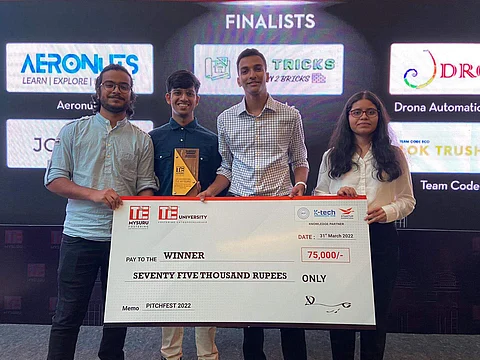

It can be said that farming is one of the noblest professions out there since one is responsible for feeding thousands of people. To assist a farmer with technology is, therefore, a noble act in itself. By helping to develop a technology that identifies water sources underground, a team of four students from the CMR Institute of Technology (CMRIT) in Bengaluru is making waves in not just the tech realm, but also when it comes to holding their ground in terms of their ethics.
The team consisting of Pratik Mukesh Bharuka, Vaishnavi Patil, Arpan Abhishek and Yashwanth Jain, is made entirely of Computer Science Engineering students but with a commitment to revolutionising agriculture. We caught up with Pratik, a final-year student at CMRIT, to understand the story behind the project Lok Trusha - Water to your borestep.
Narrating the personal ordeal that led to the illumination of the idea for the project, Pratik says, "Back in our first year, we were staying in the college hostel and we had to face a lot of problems due to the poor quality of water being supplied to us via water tankers. It was not pure enough to drink and besides, we were facing hair loss due to it as well. The principal assured us that they were trying to dig a borewell but despite their best efforts, they couldn't find water below and the problem persisted. We realised that this is a big problem everywhere so we went ahead and discussed it with the innovation cell of the college." He goes on to say that upon realising the gravity of the problem and knowing that even farmers face the same crisis, he and his friends thought about building an application that locates water sources underground.
The budding idea was first put forward by the team of four at the Smart India Hackathon in 2019, where they finished second. "That proved vital as we then believed in the immense potential our project had," Pratik adds.
Learning on the go
When asked about the actual science behind the technology and how the team went about their business, Pratik says, "When we first started digging up data for our process, we realised that India does not have any data for groundwater that is openly available. Whatever data was available was either not dependable or just obsolete." Being among those who don't get bogged down easily, Pratik and Co kept looking further until they hit upon inspiration. "We checked out the solutions from other countries. We followed in the footsteps of countries like Japan and Germany to find that remote sensing data could be the answer to our problem. To our joy, we found that ISRO had just then launched a satellite that could fetch this data."
But the ISRO data was not meant for public access. "We contacted some professors at IIT Gandhinagar who are working in the field of hydrology from whom we procured a sample data set based on which we developed a machine learning genetic algorithm." The COVID outbreak was a crucial period for the team as they continued to improve their project. "We were lucky to participate in a lot of competitions, even internationally as they were held in virtual mode. More than just being a part of such events, we were thrilled to meet and receive feedback from experts and industry leaders," Pratik explains.
At the TiE Pitchfest 2022, which the team won, they were introduced to several industry experts and leaders by TiE Mysuru, one of whom even lent them the helping hand of sharing the ISRO remote sensing data which would elevate the practicality of their work. Speaking on the current efforts, Pratik says, "We are in the process of mapping the data using geographic information systems. Our idea is to help the government recharge the activities that are dependent on groundwater."
What's the aim here?
When asked about what the project ultimately aims to do, Pratik elucidates, "The finished technology would give a three-dimensional view of how and where the water would be available. It will help in identifying aquifers, which are basically underwater lakes that recharge the groundwater table. The end goal is to work with the government here at home in India."
The sense that one gets from the Lok Trusha project is that they are driven toward solving a problem for the public instead of focusing on the revenue generation bit first. When asked if data like the ISRO remote sensing one should be made public, Pratik is quick to defend the reason why it should not be in the public domain. "This would lead to overexploitation by people who have access to the technology for sourcing water from the ground. People could be charged exorbitantly for the same as well. The way we are different is that we wish to be a consulting agency for the government. We want to only help the government plan recharge activities," Pratik explains, laying out the ethical conundrum.
Pratik and his team are set to represent India in the global finals of TiE PitchFest at Stanford University, the USA in September this year. They are the only winners from Karnataka to be among the top 30 from different parts of the globe to reach this level in the competition.
The road has been long and winding for the Lok Trusha project and there have been thorns along the way as well. "The main dependency is on real-time data and figuring out how to procure it was a roadblock. So, if ISRO stops providing it one day out of the blue, we will be set back. Secondly, while reaching out to experts over email, we would not always be believed because after all, we were just second-year Engineering students," Pratik says.
